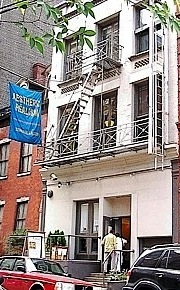Aesthetic Realism

The Aesthetic Realism Foundation
is located in SoHo (NYC) |
|
| Purpose | Aesthetic Realism, founded in 1941 by poet and critic Eli Siegel (1902-78), is a philosophy dedicated to the understanding of, and greater respect for, people, art, and reality. |
|---|---|
| Coordinates | 40°43′34″N 73°59′56″W / 40.725989°N 73.99882°W |
|
Chair
|
Ellen Reiss |
| Website | AestheticRealism.org |
Aesthetic Realism is the philosophy founded by poet and critic Eli Siegel (1902–1978) in 1941. It is based on three core principles. First, the deepest desire of every person is to like the world on an honest or accurate basis. Second, the greatest danger for a person is to have contempt for the world and what is in it—contempt defined as the false importance or glory from the lessening of things not oneself. Third, the study of what makes for beauty in art is a guide for a good life: "All beauty is a making one of opposites, and the making one of opposites is what we are going after in ourselves."
The philosophy is principally taught at the Aesthetic Realism Foundation, a nonprofit educational foundation based in SoHo, New York City, through a variety of lectures, classes in poetry, anthropology, art, music, and individual consultations.
The Foundation faced controversy for its assertion that men changed from homosexuality through study of this philosophy. In 1990, it stopped presentations and consultations on this subject, explaining that it did not want to be involved in the atmosphere of anger surrounding the issue, and saying that "we do not want this matter, which is certainly not fundamental to Aesthetic Realism, to be used to obscure what Aesthetic Realism truly is: education of the largest, most cultural kind."
Aesthetic Realism is based on the idea that reality, or the world, has a structure that is beautiful. Siegel identified beauty as the making one, or unity, of opposites.
In Siegel’s critical theory, "the resolution of conflict in self is like the making one of opposites in art." A successful novel, for example, composes opposites that people are trying to put together: oneness and manyness, intensity and calm, sameness and change. His studies led him to conclude that any successful work of art or music combines essential dualities. In the philosophy of Aesthetic Realism, Siegel developed this concept, writing that the arts and sciences all give evidence that reality has an aesthetic nature. He described the world as having a construction like art: it, too, is composed of opposites. In Siegel's eyes, freedom at one with order could be seen in an electron, a tree, or the solar system. Siegel reasoned, "If...the structure of the world corresponds to the structure [of art], that much the world may be beautiful in the deepest sense of the word; and therefore can be liked."
A primary concept of Aesthetic Realism is that the world can be liked honestly by seeing it as an aesthetic oneness of opposites. Further, a core teaching of Aesthetic Realism is that it is "every person's deepest desire to like the world on an honest or accurate basis."
However, Siegel recognized another competing desire which drives humans away from such an appreciation—the desire to have contempt for the world and what is in it, in order to make oneself feel more important. Siegel argued that when a person seeks self-esteem through contempt—"the addition to self through the lessening of something else"—he or she is unjust to people and things. Contempt, the philosophy maintains, may seem like a triumph, but ultimately results in self-dislike and mental distress, and lessens the capacity of one's mind to perceive and feel in the fullest manner. Siegel held that, in the extreme, contempt causes insanity.
...
Wikipedia
